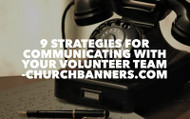9 Strategies for Communicating with your Volunteer Team
Posted by Adam on 11th Sep 2018
 So you've built your guest services team at your church, recruited the perfect people for the 5 essential positions, (learn what those 5 positions are and how to fill them with our free ebook!) and the team momentum is moving steadily.
So you've built your guest services team at your church, recruited the perfect people for the 5 essential positions, (learn what those 5 positions are and how to fill them with our free ebook!) and the team momentum is moving steadily.
Then it happens: There's something you need to communicate to the whole team. Adding a service to your weekend schedule, adjusting your team's arrival time, or providing everyone with a team t-shirt for the summer are all things that the whole team needs to know about.
So how can you communicate with your whole team, large or small, when this person only checks email once a week and that person isn't on facebook? You'll rarely get 100% attendance at your in-person meetings on a Saturday morning or an evening during the weeks, so how can you keep your team in the loop?
Here are 9 strategies to build communication channels with your team when they need to hear information directly from you:
Connect with people where they are
Anytime you're communicating with your team, you'll need to communicate in multiple ways. Don't insist that everyone has to check their email every Friday morning to look for your communications, or that participating on your team requires someone to use Facebook regularly. Be prepared, as the team leader, to use multiple channels to communicate your message, which leads to...
Ask your team how they would like to receive communications
 There are 2 opportunities to do this: Before you send a communication and after someone mentions that they didn't receive a communication.
There are 2 opportunities to do this: Before you send a communication and after someone mentions that they didn't receive a communication.
Before is always best when possible. At your next team meeting or before services for the next few weeks, ask your team members how they would like to receive both urgent and non-urgent communications. Maybe email is best for non-urgent (like a reminder for arrival times) and text is best for urgent (like So-and-so is sick today. Are you available to fill in?)
When someone says "I didn't know that was happening" and you've communicated it in multiple ways, then ask "What's the best way to communicate with you next time?"
Make this question part of the conversation for new team members so they can know what to expect for team communications.
Start a facebook group
A group is different from a page in that a group is more like a conversation. Facebook groups are often used for buy and sell groups, hand me down groups, service swaps or people who share common interests that want to have conversations. A Facebook page is better for a business who wants to promote their own information. Typical reach on a facebook page is about 5-10% of the followers. Small groups of 20-30 members see nearly 100% reach within their group.
For the team members that are on facebook, this is an excellent way to build friendships, mention and celebrate birthdays, ask questions or take polls, and, as part of that conversation, communicate team information when necessary.
Use Video
 It may seem counter-intuitive to create a video for someone to watch when they can read an email at their convenience or listen to a voicemail, but video has quickly gained traction as the most effective medium on any social media channel. Oen your phone or laptop hit record with the built-in camera and communicate as if you were leading a team meeting.
It may seem counter-intuitive to create a video for someone to watch when they can read an email at their convenience or listen to a voicemail, but video has quickly gained traction as the most effective medium on any social media channel. Oen your phone or laptop hit record with the built-in camera and communicate as if you were leading a team meeting.
For each team, the format may look a little different. For one team, a 10-minute video with "Here's what's coming up this month" may be the most effective, while for other teams a 2-3 minute video each week may be easier to process.
Try a few options and see what resonates best with your team, and be willing to adjust as you learn what works. Post the video to your facebook group, then make it an "unlisted" video on YouTube (so it can't be found in a search) and send the link to your team through email and text message.
Collect and update your team's contact information
I know this seems obvious. If you're going to send your team an email, you'll need their email addresses, but consider how many times you've gotten a bounced back email address, or someone mentions that they haven't received your email (because the address you have on file goes to an old address they're not using anymore). Set a reminder every few months to ask your team for their current contact information.
Be consistent
 Pick a day and time to send out non-urgent communications and be consistent so your team expects it, and can let you know if they don't see it. This could be every Monday at 9am, or every Sunday evening as a summary of the weekend, or the first Saturday of the month.
Pick a day and time to send out non-urgent communications and be consistent so your team expects it, and can let you know if they don't see it. This could be every Monday at 9am, or every Sunday evening as a summary of the weekend, or the first Saturday of the month.
Urgent communications, like "Someone is sick today and we need someone to fill in," are going to be on an as-needed basis.
Pre-Service team meetings
If you have something that's not urgent, use your pre-service team meeting as a reminder of something coming up. You may not have your full team serving every week, but if you have 3 or 4 weeks notice, then there's a good chance you'll see your full team over those weeks.
Include a note on pre-service checklists
 Each week, have your team is complete a pre-service checklist. This can include clearing sidewalks of debris or snow, checking for fingerprints on windows, prepping the coffee station and sweeping the floor. (find out more in our free ebook: Huddle Up!)
Each week, have your team is complete a pre-service checklist. This can include clearing sidewalks of debris or snow, checking for fingerprints on windows, prepping the coffee station and sweeping the floor. (find out more in our free ebook: Huddle Up!)
This preservice checklist is a great place to make a note about something coming up. Use a colored sticky note or a red pen to standout from your actual checklist, so your team members will know to read that note!
Know when to Use Public and Private Communications
Have an idea that you'd like everyone's feedback on? Public communications - facebook group, group email or pre-service checklist. Have something that's only affecting a few people? Send them a private communication.
If you have 3 people on your team consistently showing up late, have a conversation with just those 3 people. If you make that a team-wide communication, they all know who you're really talking to anyway.
Maintain the respect of your team, and keep communications as relevant and applicable as possible to maintain engagement with future communcations.





























